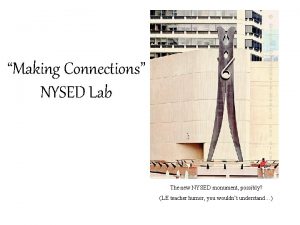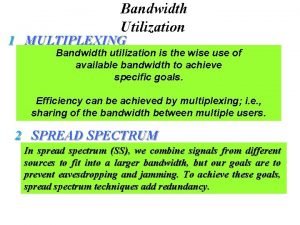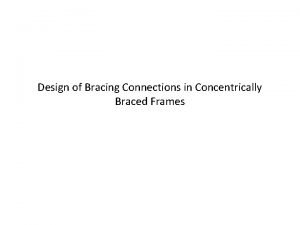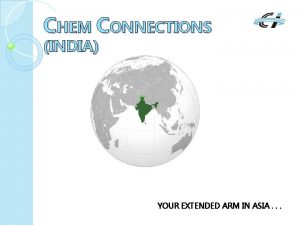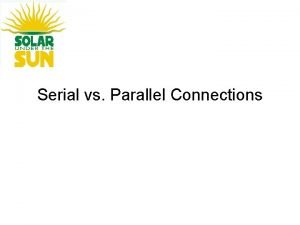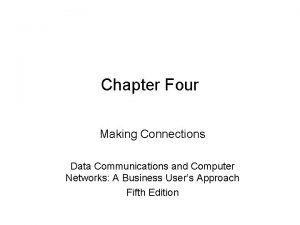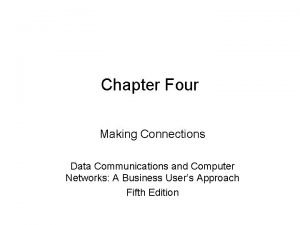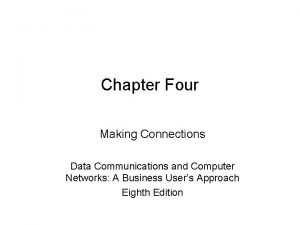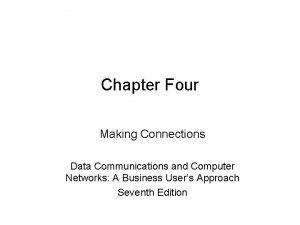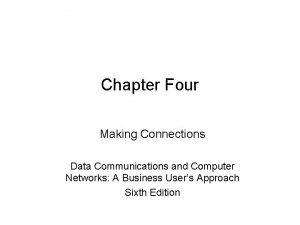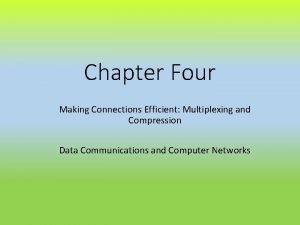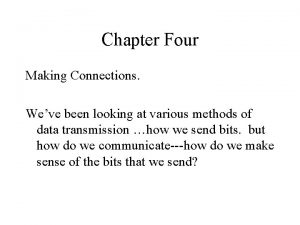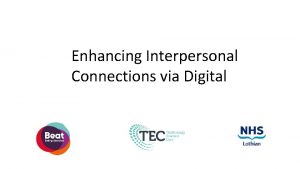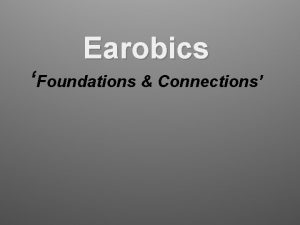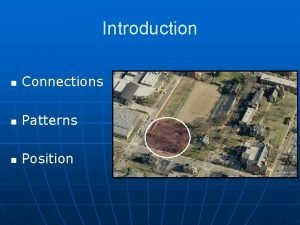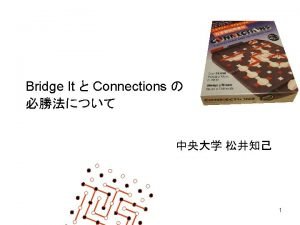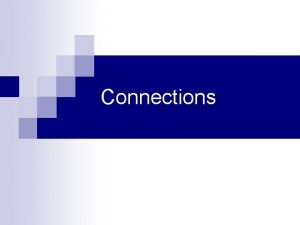Chapter Four Making Connections 1 Chapter Four Making


































- Slides: 34

Chapter Four Making Connections 1

Chapter Four - Making Connections Introduction • Connecting peripheral devices to a computer has, in the past, been a fairly challenging task • Newer interfaces have made this task much easier • Let’s examine the interface between a computer and a device. This interface occurs primarily at the physical layer 2

How do I connect peripheral devices to my computer? • Practical Computer Literacy, 2 nd edition Chapter 2 3

Chapter Four - Making Connections Half Duplex, Full Duplex, and Simplex Connections • A half duplex connection transmits data in both directions but in only one direction at a time • A full duplex connection transmits data in both directions and at the same time • A simplex connection can transmit data in only one direction 4

Chapter Four - Making Connections Interface Standards • There are essentially two types of standards – Official standards, created by standards making organizations such as ITU (International Telecommunications Union), IEEE (Institute for Electrical and Electronics Engineers), EIA (Electronics Industries Association), ISO (International Organization for Standards), and ANSI (American National Standards Institute) – De-facto standards – protocols created by other groups that are not official standards but because of their widespread 5 use, become “almost” standards

Chapter Four - Making Connections Interface Standards • There are four possible components to an interface standard: – – Electrical component Mechanical component Functional component Procedural component 6

Chapter Four - Making Connections The Four Components • The electrical component deals with voltages, line capacitance, and other electrical characteristics • The mechanical component deals with items such as the connector or plug description. 7

Chapter Four - Making Connections The Four Components • The functional component describes the function of each pin or circuit that is used in a particular interface • The procedural component describes how the particular circuits are used to perform an operation 8

Chapter Four - Making Connections Two Example Interfaces • In order to better understand the four components of an interface, let’s examine two popular interface standards – EIA-232 F – an older standard originally designed to connect a modem to a computer – USB (Universal Serial Bus) – a newer standard that is much more powerful than EIA-232 F 9

Chapter Four - Making Connections Universal Serial Bus (USB) • The USB interface is a modern standard for interconnecting a wide range of peripheral devices to computers • Supports plug and play • Can daisychain multiple devices • USB 2. 0 can support 480 Mbps (USB 1. 0 is only 12 Mbps) 10

Chapter Four - Making Connections Universal Serial Bus (USB) • The USB interface defines all four components • The electrical component defines two wires VBUS and Ground to carry a 5 volt signal, while the D+ and D- wires carry the data and signaling information • The mechanical component precisely defines the size of four different connectors and uses only four wires (the metal shell counts as one more connector) 11

Chapter Four - Making Connections Universal Serial Bus (USB) 12

Chapter Four - Making Connections Universal Serial Bus (USB) • The functional and procedural components are fairly complex but are based on the polled bus • The computer takes turns asking each peripheral if it has anything to send. 13

Chapter Four - Making Connections Asynchronous Connections • A type of connection defined at the data link layer • To transmit data from sender to receiver, an asynchronous connection creates a one-character package called a frame • Added to the front of the frame is a Start bit, while a Stop bit is added to the end of the frame • An optional parity bit can be added which can be used to detect errors 14

Chapter Four - Making Connections Asynchronous Connections 15

Chapter Four - Making Connections Asynchronous Connections 16

Chapter Four - Making Connections Asynchronous Connections • The term asynchronous is misleading here because you must always maintain synchronization between the incoming data stream and the receiver • Asynchronous connections maintain synchronization by using small frames with a leading start bit 17

Chapter Four - Making Connections Synchronous Connections • A second type of connection defined at the data link layer • A synchronous connection creates a large frame that consists of header and trailer flags, control information, optional address information, error detection code, and data • A synchronous connection is more elaborate but transfers data in a more efficient manner 18

Chapter Four - Making Connections Synchronous Connections 19

Efficiency of Asynchronous Connection • • • 1 start bit 7 data bit 1 parity bit 1 stop bit Efficiency: γ=7/(1+7+1+1)=7/10=70%

Efficiency of Synchronous Connection • • • 2 bytes of Flag (at the two ends) 1 byte of control field 2 bytes of address 1000 bytes of data 2 bytes of CRC (checksum) Efficiency: 1000/(2+1+2+1000+2)=99%

Chapter Four - Making Connections Isochronous Connections • A third type of connection defined at the data link layer used to support real-time applications • The data must be delivered at just the right speed (real -time) – not too fast and not too slow • Typically an isochronous connection must allocate resources on both ends to maintain real-time • USB (and Firewire) can both support isochronous 22

Chapter Four - Making Connections Terminal-to-Mainframe Connections • A point-to-point connection is a direct, unshared connection between a terminal and a mainframe computer • A multipoint connection is a shared connection between multiple terminals and a mainframe computer • The mainframe is the primary and the terminals are the secondaries 23

Chapter Four - Making Connections Terminal-to-Mainframe Connections 24

Chapter Four - Making Connections Terminal-to-Mainframe Connections • To allow a terminal to transmit data to a mainframe, the mainframe must poll the terminal • Two basic forms of polling: roll-call polling and hub polling • In roll-call polling, the mainframe polls each terminal in a round-robin fashion • In hub polling, the mainframe polls the first terminal, and this terminal passes the poll onto the next 25 terminal

Chapter Four - Making Connections Terminal-to-Mainframe Connections • Roll call polling 26

Chapter Four - Making Connections Making Computer Connections In Action • The back panel of a personal computer has many different types of connectors, or connections: – – RS-232 connectors USB connectors Parallel printer connectors Serial port connectors 27

Chapter Four - Making Connections Making Computer Connections In Action 28

Chapter Four - Making Connections Making Computer Connections In Action • • • 1 and 2 – DIN connectors for keyboard and mouse 3 – USB connectors 4 and 6 – DB-9 connectors 5 – Parallel port connector (Centronics) 7, 8, and 9 – audio connectors Will Bluetooth or ? ? ? replace these someday? 29

Chapter Four - Making Connections Making Computer Connections In Action • A company wants to transfer files that are typically 700 K chars in size • If an asynchronous connection is used, each character will have a start bit, a stop bit, and maybe a parity bit • 700, 000 chars * 11 bits/char (8 bits data + start + stop + parity) = 7, 700, 000 bits 30

Example • 1) If an asynchronous connection: • How many bits needed to transmit 500 bytes? • Note: totals of bits is 11 bits per byte of data when you consider 8 data bits + 1 start bit + 1 stop bit + 1 parity bit.

Chapter Four - Making Connections Making Computer Connections In Action • If a synchronous connection is used, assume maximum payload size – 1500 bytes • To transfer a 700 K char file requires 467 1500 character (byte) frames • Each frame will also contain 1 -byte header, 1 -byte address, 1 -byte control, and 2 -byte checksum, thus 5 bytes overhead 32

Chapter Four - Making Connections Making Computer Connections In Action • 1500 bytes payload + 5 byte overhead = 1505 byte frames • 467 frames * 1505 bytes/frame = 716, 380 bytes, or 5, 731, 040 bits • Significantly less data using synchronous connection 33

Example • 1) If an synchronous connection: • The parts amount to a 1 -byte header, 1 byte address, 1 -byte control, and 2 byte checksum plus the original data. The maximum payload size is 1500 bytes. • How many bits needed to transmit 500 bytes? 34
 Making connections task cards
Making connections task cards Making connections lab
Making connections lab Making connections image
Making connections image Making connections
Making connections Text-to-self meaning
Text-to-self meaning Tug of war
Tug of war Four 1 kbps connections are multiplexed together
Four 1 kbps connections are multiplexed together Transoceanic encounters and global connections
Transoceanic encounters and global connections China and the world east asian connections
China and the world east asian connections Chapter 8 china and the world east asian connections
Chapter 8 china and the world east asian connections Traditions and encounters chapter 23
Traditions and encounters chapter 23 Chapter 22 transoceanic encounters and global connections
Chapter 22 transoceanic encounters and global connections Chapter 22 traditions and encounters
Chapter 22 traditions and encounters Transoceanic encounters and global connections
Transoceanic encounters and global connections Binghamton university powerpoint template
Binghamton university powerpoint template Fuzzy front end
Fuzzy front end Text to world connections examples
Text to world connections examples Balanced delta-wye connection
Balanced delta-wye connection Design of steel roof truss
Design of steel roof truss Dshs working connections
Dshs working connections Bc science connections 8 answer key
Bc science connections 8 answer key Yakima neighborhood health services
Yakima neighborhood health services Career clusters framework
Career clusters framework Learning connections inventory
Learning connections inventory Different types of welding joints
Different types of welding joints Nexus connections academy
Nexus connections academy New global connections
New global connections New global connections unit test
New global connections unit test New connections academy palatine
New connections academy palatine Native american connections housing
Native american connections housing Executive connections
Executive connections Essential connections
Essential connections Hss bracing connections
Hss bracing connections Chem connections india
Chem connections india Stellate cells
Stellate cells

